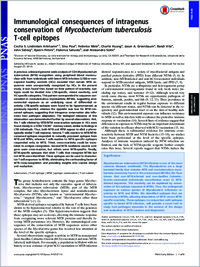Immunological consequences of intragenus conservation of Mycobacterium tuberculosis T-cell epitopes
- Lindestam Arlehamn, Cecilia S. Division of Vaccine Discovery, La Jolla Institute for Allergy and Immunology, La Jolla, CA 92037
- Paul, Sinu Division of Vaccine Discovery, La Jolla Institute for Allergy and Immunology, La Jolla, CA 92037
- Mele, Federico Institute for Research in Biomedicine (IRB), Faculty of Biomedical Sciences, Università della Svizzera italiana, Switzerland
- Huang, Charlie Division of Vaccine Discovery, La Jolla Institute for Allergy and Immunology, La Jolla, CA 92037
- Greenbaum, Jason A. Division of Vaccine Discovery, La Jolla Institute for Allergy and Immunology, La Jolla, CA 92037
- Vita, Randi Division of Vaccine Discovery, La Jolla Institute for Allergy and Immunology, La Jolla, CA 92037
- Sidney, John Division of Vaccine Discovery, La Jolla Institute for Allergy and Immunology, La Jolla, CA 92037
- Peters, Bjoern Division of Vaccine Discovery, La Jolla Institute for Allergy and Immunology, La Jolla, CA 92037
- Sallusto, Federica Institute for Research in Biomedicine (IRB), Faculty of Biomedical Sciences, Università della Svizzera italiana, Switzerland
- Sette, Alessandro Division of Vaccine Discovery, La Jolla Institute for Allergy and Immunology, La Jolla, CA 92037
-
29.12.2014
Published in:
- Proceedings of the national academy of sciences of the United States of America. - 2015, vol. 112, no. 2, p. E147-E155
English
A previous unbiased genome-wide analysis of CD4 Mycobacterium tuberculosis (MTB) recognition using peripheral blood mononuclear cells from individuals with latent MTB infection (LTBI) or nonexposed healthy controls (HCs) revealed that certain MTB sequences were unexpectedly recognized by HCs. In the present study, it was found that, based on their pattern of reactivity, epitopes could be divided into LTBI-specific, mixed reactivity, and HC-specific categories. This pattern corresponded to sequence conservation in nontuberculous mycobacteria (NTMs), suggesting environmental exposure as an underlying cause of differential reactivity. LTBI-specific epitopes were found to be hyperconserved, as previously reported, whereas the opposite was true for NTM conserved epitopes, suggesting that intragenus conservation also influences host pathogen adaptation. The biological relevance of this observation was demonstrated further by several observations. First, the T cells elicited by MTB/NTM cross-reactive epitopes in HCs were found mainly in a CCR6+CXCR3+ memory subset, similar to findings in LTBI individuals. Thus, both MTB and NTM appear to elicit a phenotypically similar T-cell response. Second, T cells reactive to MTB/NTM-conserved epitopes responded to naturally processed epitopes from MTB and NTMs, whereas T cells reactive to MTB-specific epitopes responded only to MTB. Third, cross-reactivity could be translated to antigen recognition. Several MTB candidate vaccine antigens were cross-reactive, but others were MTB-specific. Finally, NTM-specific epitopes that elicit T cells that recognize NTMs but not MTB were identified. These epitopes can be used to characterize T-cell responses to NTMs, eliminating the confounding factor of MTB cross-recognition and providing insights into vaccine design and evaluation.
- Language
-
- English
- Classification
- Medicine
- License
-
License undefined
- Open access status
- hybrid
- Identifiers
-
- RERO DOC 324300
- DOI 10.1073/pnas.1416537112
- ARK ark:/12658/srd1319030
- Persistent URL
- https://n2t.net/ark:/12658/srd1319030
Statistics
Document views: 199
File downloads:
- Texte intégral: 190
